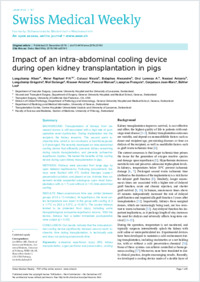Impact of an intra-abdominal cooling device during open kidney transplantation in pigs
- Longchamp, Alban Department of Vascular Surgery, Lausanne University Hospital and the University of Lausanne, Switzerland
- Meier, Raphael P. H. Visceral and Transplant Surgery, Department of Surgery, Geneva University Hospitals and Medical School, Geneva, Switzerland / Transplant Surgery, University of California San Francisco, CA, USA
- Colucci, Nicola Visceral and Transplant Surgery, Department of Surgery, Geneva University Hospitals and Medical School, Geneva, Switzerland
- Balaphas, Alexandre Visceral and Transplant Surgery, Department of Surgery, Geneva University Hospitals and Medical School, Geneva, Switzerland
- Orci, Lorenzo A. Visceral and Transplant Surgery, Department of Surgery, Geneva University Hospitals and Medical School, Geneva, Switzerland
- Nastasi, Antonio Visceral and Transplant Surgery, Department of Surgery, Geneva University Hospitals and Medical School, Geneva, Switzerland
- Longchamp, Grégoire Visceral and Transplant Surgery, Department of Surgery, Geneva University Hospitals and Medical School, Geneva, Switzerland
- Moll, Solange Division of Clinical Pathology, Department of Pathology and Immunology, Geneva University Hospital and Medical School, Geneva, Switzerland
- Klauser, Antoine Department of Radiology and Medical Informatics, University of Geneva, Switzerland
- Pascual, Manuel Transplantation Centre, Centre Hospitalier Universitaire Vaudois and University of Lausanne, Switzerland
- Lazeyras, François Department of Radiology and Medical Informatics, University of Geneva, Switzerland
- Corpataux, Jean-Marc Department of Vascular Surgery, Lausanne University Hospital and the University of Lausanne, Switzerland
- Bühler, Leo Faculty of Science and Medicine, Section of Medicine, University of Fribourg, Switzerland
-
23.12.2019
Published in:
- Swiss Medical Weekly. - 2019, vol. 149, no. 5152, p. w20143
English
Transplantation of kidneys from deceased donors is still associated with a high rate of postoperative renal dysfunction. During implantation into the recipient, the kidney rewarms. This second warm ischaemia time, which is not monitored, is harmful especially if prolonged. We recently developed an intra-abdominal cooling device that efficiently prevents kidney rewarming during robotic transplantation, and prevents ischaemia-reperfusion injuries. We tested the benefits of this cooling device during open kidney transplantation in pigs.METHODS: Kidneys were procured from large pigs by open bilateral nephrectomy. Following procurement, kidneys were flushed with 4°C Institut Georges Lopez-1 preservation solution, and placed on ice. Animals then underwent double sequential autologous open renal transplantation with (n = 7) and without (n = 6) intra-abdominal cooling.RESULTS: Mean anastomosis time was similar between groups (43.9 ± 13 minutes). At reperfusion, the renal cortex temperature was lower in the group with cooling (4.3 ± 1.1°C vs 26.5 ± 5.5°C, p <0.001). The cooled kidneys tended to be protected from injury, including some histopathological ischaemia-reperfusion lesions. With the device, kidneys had a better immediate postoperative urine output (p = 0.05).CONCLUSION: Our results indicate that the intra-abdominal cooling device significantly reduced second warm ischaemic time during transplantation, is technically safe and does not prolong anastomotic time.
- Faculty
- Faculté des sciences et de médecine
- Department
- Master en médecine
- Language
-
- English
- Classification
- Medicine
- License
-
License undefined
- Identifiers
-
- RERO DOC 328006
- DOI 10.4414/smw.2019.20143
- Persistent URL
- https://folia.unifr.ch/unifr/documents/308355
Statistics
Document views: 130
File downloads:
- pdf: 159
